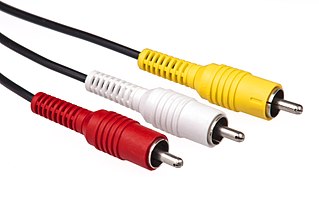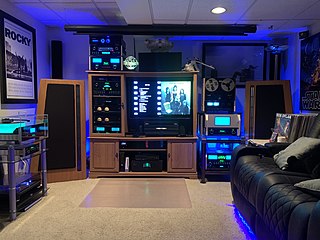An audiophile is a person who is enthusiastic about high-fidelity sound reproduction. An audiophile seeks to reproduce recorded music to achieve high sound quality, typically in a quiet listening space and in a room with good acoustics.

The RCA connector is a type of electrical connector commonly used to carry audio and video signals. The name RCA derives from the company Radio Corporation of America, which introduced the design in the 1930s. The connector’s male plug and female jack are called RCA plug and RCA jack.

Home cinema, also called home theaters or theater rooms, are home entertainment audio-visual systems that seek to reproduce a movie theater experience and mood using consumer electronics-grade video and audio equipment that is set up in a room or backyard of a private home. Some studies show films are rated better and generate more intense emotions when watched in a movie theater, however, convenience is a major appeal for home cinemas. In the 1980s, home cinemas typically consisted of a movie pre-recorded on a LaserDisc or VHS tape; a LaserDisc Player or VCR; and a heavy, bulky large-screen cathode ray tube TV set, although sometimes CRT projectors were used instead. In the 2000s, technological innovations in sound systems, video player equipment and TV screens and video projectors have changed the equipment used in home cinema set-ups and enabled home users to experience a higher-resolution screen image, improved sound quality and components that offer users more options. The development of Internet-based subscription services means that 2016-era home theatre users do not have to commute to a video rental store as was common in the 1980s and 1990s.
A digital video recorder (DVR) is an electronic device that records video in a digital format to a disk drive, USB flash drive, SD memory card, SSD or other local or networked mass storage device. The term includes set-top boxes with direct to disk recording, portable media players and TV gateways with recording capability, and digital camcorders. Personal computers are often connected to video capture devices and used as DVRs; in such cases the application software used to record video is an integral part of the DVR. Many DVRs are classified as consumer electronic devices; such devices may alternatively be referred to as personal video recorders (PVRs), particularly in Canada. Similar small devices with built-in displays and SSD support may be used for professional film or video production, as these recorders often do not have the limitations that built-in recorders in cameras have, offering wider codec support, the removal of recording time limitations and higher bitrates.

A home theater PC (HTPC) or media center computer is a convergent device that combines some or all the capabilities of a personal computer with a software application that focuses on video, photo, audio playback, and sometimes video recording functionality. Since the mid-2000s, other types of consumer electronics, including game consoles and dedicated media devices, have crossed over to manage video and music content. The term "media center" also refers to specialized application software designed to run on standard personal computers.

A tuner is a subsystem that receives radio frequency (RF) transmissions, such as FM broadcasting, and converts the selected carrier frequency and its associated bandwidth into a fixed frequency that is suitable for further processing, usually because a lower frequency is used on the output. Broadcast FM/AM transmissions usually feed this intermediate frequency (IF) directly into a demodulator that converts the radio signal into audio-frequency signals that can be fed into an amplifier to drive a loudspeaker.
Hearst Television, Inc. is a broadcasting company in the United States owned by Hearst Communications, made up of a group of television and radio stations, and Hearst Media Production Group, a distributor of programming in broadcast syndication.
Denon is a Japanese electronics company dealing with audio equipment. The Denon brand came from a merger of Denki Onkyo and others in 1939, but it originally started as Nippon Chikuonki Shoukai in 1910 by Frederick Whitney Horn, an American entrepreneur.

A home theater in a box (HTIB) is an integrated home theater package which "bundles" together a combination DVD or Blu-ray player, a multi-channel amplifier, speaker wires, connection cables, a remote control, a set of five or more surround sound speakers and a low-frequency subwoofer cabinet. Manufacturers also have come out with the "Sound Bar," an all in one device to put underneath the television and that contains all the speakers in one unit.
Philco is an American electronics manufacturer headquartered in Philadelphia. Philco was a pioneer in battery, radio, and television production. In 1961, the company was purchased by Ford and, from 1966, renamed "Philco-Ford". Ford sold the company to GTE in 1974, and it was purchased by Philips in 1981. In North America, the Philco brand is owned by Philips. In other markets, the Philco International brand is owned by Electrolux.
A video game accessory is a distinct piece of hardware that is required to use a video game console, or one that enriches the video game's play experience. Essentially, video game accessories are everything except the console itself, such as controllers, memory, power adapters (AC), and audio/visual cables. Most video game consoles come with the accessories required to play games out of the box : one A/V cable, one AC cable, and a controller. Memory is usually the most required accessory outside of these, as game data cannot be saved to compact discs. The companies that manufacture video game consoles also make these accessories for replacement purposes as well as improving the overall experience. There is an entire industry of companies that create accessories for consoles as well, called third-party companies. The prices are often lower than those made by the maker of the console (first-party). This is usually achieved by avoiding licensing or using cheaper materials. For the mobile systems like the PlayStation Portable and Game Boy iterations, there are many accessories to make them more usable in mobile environments, such as mobile chargers, lighting to improve visibility, and cases to both protect and help organize the collection of system peripherals to. Newer accessories include many home-made things like mod chips to bypass manufacturing protection or homemade software.
Lifetime Entertainment Services (LES) is an American entertainment industry company, whose media properties are focused on women. Lifetime Entertainment Services is a subsidiary of A&E Networks, a joint venture of Hearst Communications (50%) and The Walt Disney Company (50%).
A media server is a computer appliance or an application software that stores digital media and makes it available over a network.

A video sender is a device for transmitting domestic audio and video signals wirelessly from one location to another. It is most commonly used for sending the output of a source device, such as a satellite television decoder, to a television in another part of a property and provides an alternative to cable installations.

The third season of South Park, an American animated television comedy series, aired on Comedy Central from April 7, 1999, to January 12, 2000. The season was headed by series creators Trey Parker and Matt Stone, who also served as executive producers along with Anne Garefino. The season continued to focus on the exploits of protagonists Stan, Kyle, Cartman, and Kenny in the fictional Colorado mountain town of South Park.

A digital media player is a type of consumer electronics device designed for the storage, playback, or viewing of digital media content. They are typically designed to be integrated into a home cinema configuration, and attached to a television or AV receiver or both.
The Telly home entertainment server is range of computer systems designed to store, manage, and access all forms of digital media in the home. Based on Interact-TV's Linux Media Center software, it provides user managed libraries for music, photos, and all forms of video from recorded television programming to DVDs.

Home audio systems refer to audio consumer electronics designed for home entertainment, such as integrated systems like shelf stereos and music centers, as well as individual components like loudspeakers and surround sound receivers. The evolution of home audio began with Edison's phonograph, transitioning from monaural to stereophonic sound in the 1950s and 60s. The term "hi-fi" emerged, highlighting sound accuracy and minimal distortion. Audio equipment evolved from large wooden cabinets to compact units. The 1970s introduced enhancements like quadraphonic sound and technologies like Dolby Pro Logic. The 1970s and 1980s also saw the rise of component-based stereo systems. Cassette decks became a staple in the 1970s. Integrated systems, termed "music centers" gained popularity in the 1980s. Table systems and compact radio receivers emerged as entertainment devices, with some offering features like cassette players and CD functionalities. Audiophile systems prioritize high-quality music formats and specialized equipment like premium turntables, digital-to-analog converters, and other high-end devices, with some enthusiasts preferring the unique sound characteristics of vinyl records and vacuum tubes. Modern systems often emphasize home cinema applications to enhance the audio experience beyond standard TV speakers.
The Hearst Media Production Group is an American media and production company based in New York City, New York as a division of the Hearst Television subsidiary of Hearst Communications, with three additional offices in Boston, Washington, D.C., and Burbank, California. Many of HMPG's programs comply with federally mandated educational and informational requirements.










